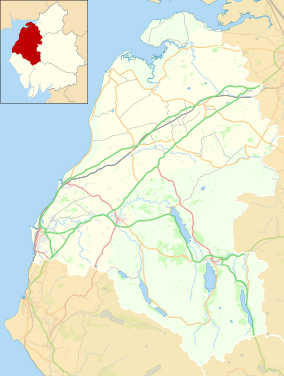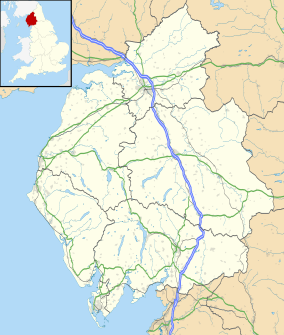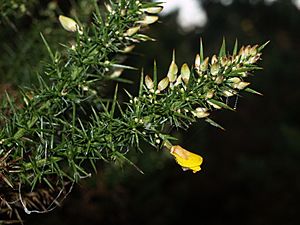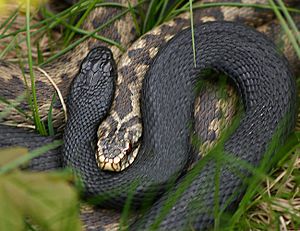Salta Moss facts for kids
Quick facts for kids Salta Moss |
|
|---|---|
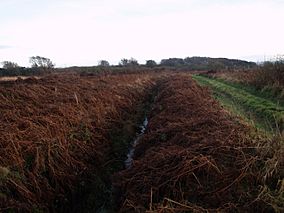
Farm track and irrigation channel on Salta Moss.
|
|
| Location | Holme St. Cuthbert civil parish, Cumbria, UK |
| Nearest town | Maryport |
| Area | 45.62 ha (112.7 acres) |
| Elevation | 7.6m |
| Designated | August 1982 |
| Named for | The hamlet of Salta |
| Governing body | Natural England |
Salta Moss is a special natural area in Cumbria, United Kingdom. It is a type of wetland called a blanket mire. This means it's a bog that covers a large area, like a blanket.
Salta Moss is so important that it's been named a Site of Special Scientific Interest (SSSI). This protects its unique plants and animals. It was officially recognized in August 1982. The area is about 45.6 hectares, which is like 112 football fields!
Contents
Where is Salta Moss Located?
Salta Moss is found in a small place called Salta. This hamlet is part of the Holme St. Cuthbert parish in Cumbria. It's close to the coast, about 0.8 kilometers (0.5 miles) from the sea. The land is about 7.6 meters (25 feet) above sea level.
Other nearby places include Dubmill, Edderside, Hailforth, and Mawbray. The coastline here is also very special. It's part of the Solway Coast, which is an Area of Outstanding Natural Beauty (AONB). This means the landscape is protected for its amazing views.
The sea near Salta Moss, called Allonby Bay, is also a Marine Conservation Zone. This helps protect the sea creatures living there.
What Does "Salta Moss" Mean?
The word Moss in Salta Moss means a peat bog. It doesn't mean the small green plant you might see on rocks. This word comes from old English words like meos or mos.
The name Salta comes from an even older English phrase, sēalt-tir. This means "land of salt" or "salt land." Long ago, during the Anglo-Saxon era, people made salt in this part of the Solway coast. That's how the area got its name! You might even see local houses with names that include "Moss" or plants found in the area.
Ancient Discoveries at Salta Moss
Salta Moss has a cool history! In the 1980s, a very old sword was found here. It was a rapier from the Bronze Age, which means it could be as old as 1100 BC!
This ancient sword was given to the Tullie House Museum in Carlisle. You can see it on display there, showing a piece of history from Salta Moss.
Plants and Trees at Salta Moss
Salta Moss is home to many interesting bog and moor plants. You'll find Molinia caerulea, also known as purple moor grass. This grass loves wet, marshy ground. There are also different types of Ericaceae, which are commonly called heather, and gorse.
The area is called a raised blanket mire because of its climate and the thick layer of peat it has. Peat is made from partly decayed plants. There's also a small forest area and a large amount of sand under the bog.
Here are some of the main plants that make Salta Moss so special:
- Angelica sylvestris (wild angelica)
- Carex rostrata (bottle or beaked sedge)
- Erica tetralix (cross-leaved heath)
- Filipendula ulmaria (meadowsweet)
- Galium palustre (marsh-bedstraw)
- Juncus acutiflorus (sharp-flowered rush)
- Juncus effusus (common or soft rush)
- Menyanthes trifoliata (bog bean)
- Molinia caerulea (purple moor grass)
- Phragmites communis (common reed)
- Potentilla erecta (tormentil)
- Salix pentandra (bay willow)
- Sphagnum cuspidatum (feathery bog-moss)
- Sphagnum papillosum (papillose bog-moss)
- Sphagnum recurvum
- Vaccinium oxycoccos (cranberry)
Animals Living at Salta Moss
Salta Moss is a home for Vipera berus, also known as adders. These are Britain's only native venomous snakes. They like to eat small animals like voles and field mice.
While an adder bite can be painful, it's usually not dangerous for humans. Some adders here are melanistic, meaning they have very dark skin.
The site also provides shelter for roe deer. Many kinds of wild birds, both those that stay all year and those that migrate, can be seen here. It's also a breeding spot for warblers.
Protecting Salta Moss
Natural England is the group that looks after all Sites of Special Scientific Interest in England. They have noticed that some parts of Salta Moss are damaged, and other parts are at risk. This is mainly because of farming activities and the draining of water from the land.
To keep Salta Moss healthy and protected, it's very important to keep the water table high. If the land is drained too much, it puts this special place in even more danger.


